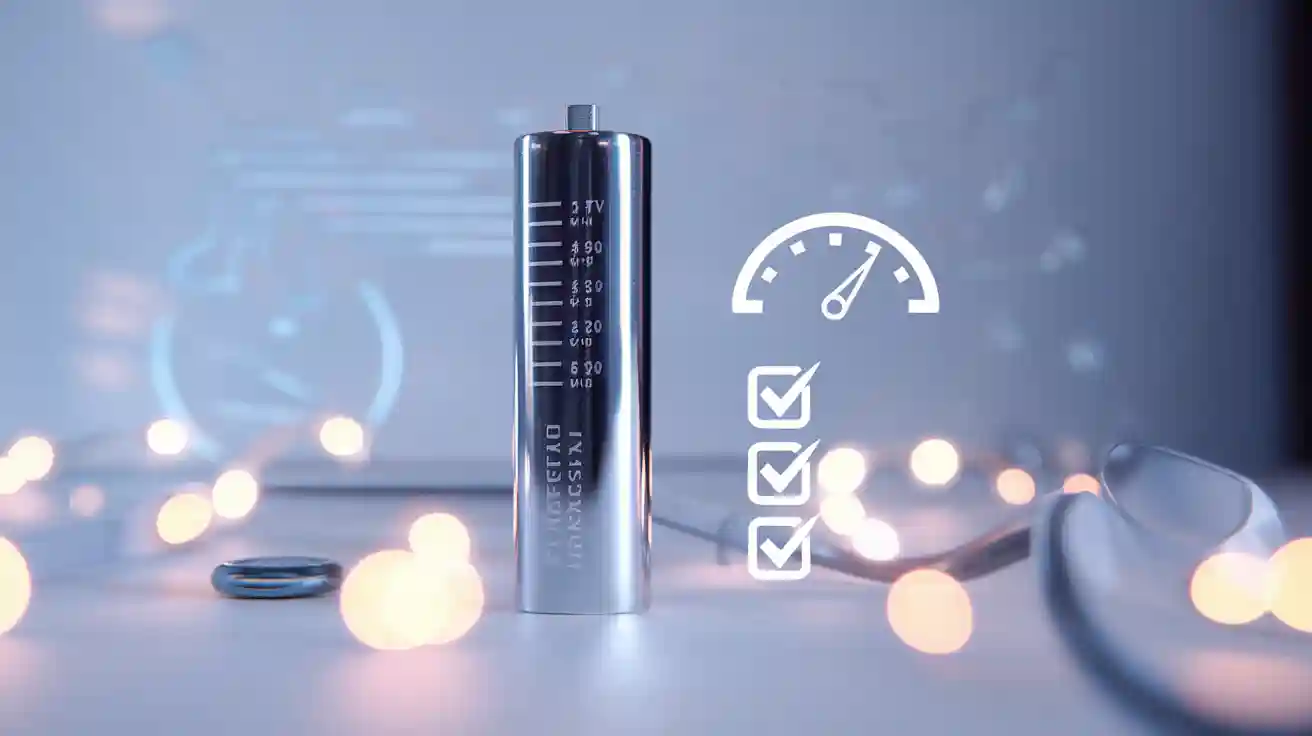
A 3.7V lithium-ion battery provides reliable power for countless portable devices. Accurate capacity ratings help users match the right li-ion battery to their needs, preventing unexpected shutdowns and ensuring optimal performance. Industry research shows that small changes in charge voltage or discharge depth can dramatically affect how long a li-ion battery lasts. For example, limiting full discharges can increase cycle life by up to 50%. The table below highlights how aging impacts li-ion battery performance:
| Effet de vieillissement | Impact on Device Performance and Battery Lifespan |
|---|---|
| Perte de capacité | Shorter device runtime and less energy storage |
| Résistance accrue | More heat, higher voltage drops, earlier shutdowns |
| Courbe de débit plus prononcée | Reduced power output, premature device shutdown |
Monitoring discharge curves and using proper charging routines help extend the life of any lithium-ion battery. Careful attention to these factors increases safety and reliability for every battery-powered device.
Capacity Ratings

What They Mean
Capacity describes how much electric charge a li-ion battery can store and deliver to a device. Manufacturers usually express this value in milliampere-hours (mAh) for smaller batteries or ampere-hours (Ah) for larger ones. The number tells users how long a battery can power a device before it needs recharging. For example, a 2000mAh li-ion battery can supply 2000 milliamps for one hour or 1000 milliamps for two hours. This measurement helps users compare different lithium-ion cell options and select the right one for their needs.
The range of capacity for a 3.7V li-ion battery varies by application. Small devices like fitness trackers and Bluetooth earphones use batteries from 500mAh to 1000mAh. Smartphones and handheld gaming consoles often require mid-range capacities between 1000mAh and 3000mAh. Tablets and portable speakers need larger batteries, from 3000mAh to 5000mAh. Devices such as laptops and drones may use batteries above 5000mAh to meet higher energy demands. The charged capacity of a battery reflects the maximum amount of energy it can deliver when fully charged.
Conseil : Always check the device manual for recommended battery capacity to ensure safe and reliable operation.
Measuring Capacity
Manufacturers and technicians use several methods to measure the capacity of a li-ion battery. The most common approach involves fully charging the battery to its maximum voltage, usually around 4.2V per lithium-ion cell. After charging, they connect a constant current load, such as a resistor, and discharge the battery while monitoring the voltage. The process stops when the voltage drops to the safe cutoff, typically 3.2V per cell. By multiplying the discharge current by the time taken to reach the cutoff voltage, they calculate the battery capacity.
Common laboratory procedure for measuring capacity:
- Charge the battery to full voltage (about 4.2V per cell).
- Attach a constant current load to discharge the battery.
- Monitor voltage to avoid dropping below the safe cutoff.
- Record the time taken to discharge from full to cutoff voltage.
- Calculate capacity using the formula: Capacity = Current × Time.
- Use a resistor with the correct rating for controlled discharge.
- Specialized testers can automate this process for accuracy.
- Avoid deep discharge to protect the battery.
Technicians also use digital multimeters to check the voltage of a li-ion battery. By comparing the voltage to known voltage-capacity curves, they estimate the remaining energy. Some testers and apps provide direct readings of capacity, making the process easier for users.
| Chemistry Type | Tension nominale | End-of-Discharge Voltage | Max Charge Voltage | Notes |
|---|---|---|---|---|
| Classic cobalt-based Li-ion (LCO) | 3.6V | 2.8–3.0V | 4.2V | Standard nominal voltage |
| Ternary lithium | 3.7V | 2.8–3.0V | 4.2V | Low internal resistance |
| Enhanced surface coating/additives | 3.8V | 2.8–3.0V | 4.35V | Needs correct charger voltage |
| Further enhanced additives | 3.85V | 2.8–3.0V | 4.4V | Higher runtime, shorter cycle life |
| Lithium iron phosphate (LFP) | 3.2V | N/A | N/A | Different chemistry, not compatible |
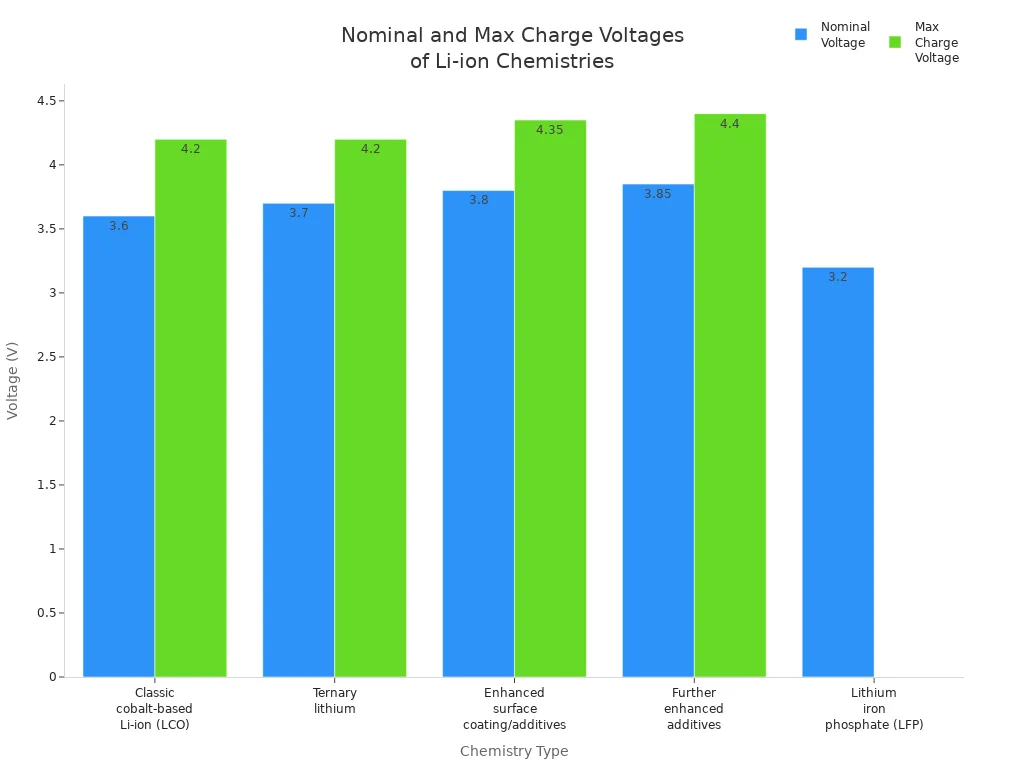
Why Ratings Matter
Capacity ratings play a critical role in device performance and user satisfaction. The capacity of a li-ion battery determines how long a device can operate before needing a recharge. Higher capacity means longer runtime, but it also increases the size and weight of the battery. Device designers must balance energy needs with portability and comfort.
Selecting the correct capacity ensures compatibility with the device’s power requirements. If the battery capacity is too low, the device may shut down early or fail to perform as expected. If the battery is too large, it may not fit the device or could cause overheating. The chemistry and voltage of the lithium-ion cell must also match the device to prevent damage.
- Battery capacity affects runtime and device usability.
- Physical size and weight must match the device design.
- Discharge rate impacts performance in high-drain devices.
- Voltage and chemistry compatibility are essential for safety.
- Certifications like UL, CE, and RoHS indicate tested reliability.
A li-ion battery with the right capacity and chemistry provides safe, efficient, and long-lasting energy for any application. Understanding these ratings helps users make informed choices and maximize device performance.
Lithium-Ion Battery Discharge Curves
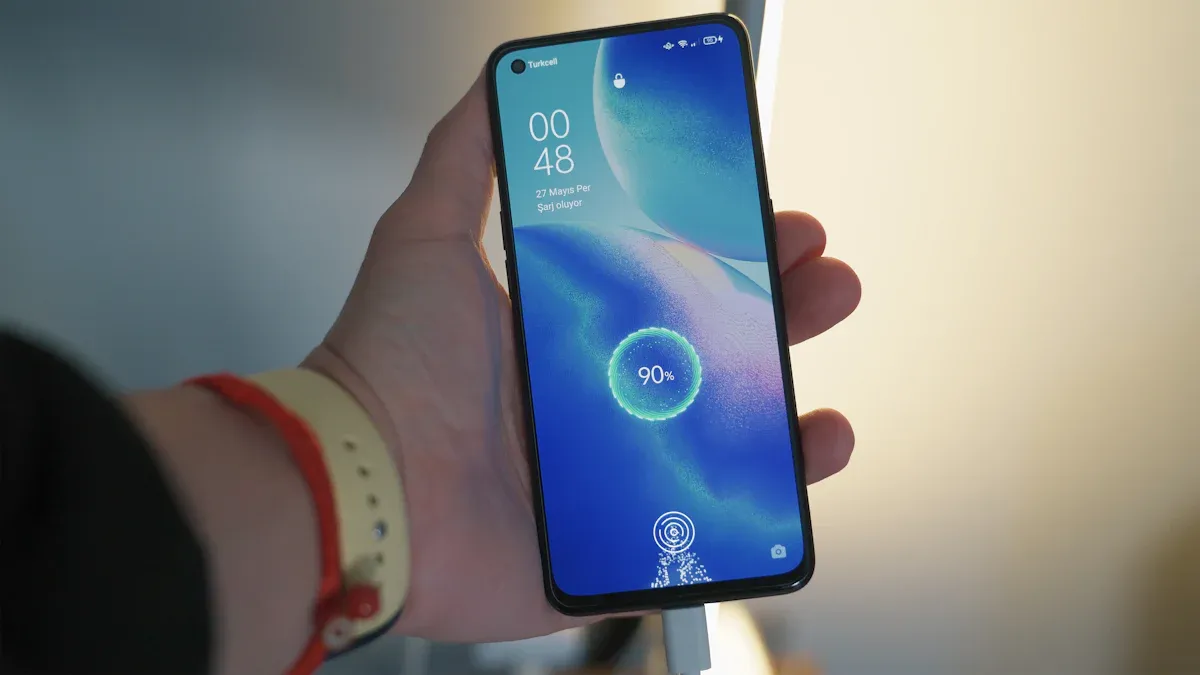
Les bases de la courbe
A lithium-ion battery follows a predictable voltage pattern during charge and discharge. The typical voltage range for a 3.7V lithium-ion cell is as follows:
- Full charge voltage: 4.2V
- Tension nominale : 3.6V to 3.7V
- Discharge cut-off voltage: 3.0V (sometimes as low as 2.8V)
- Operating safely within this range protects the battery from damage
The discharge curve of a li-ion battery starts at its highest voltage after a full charge. Most of the discharge process shows a flat plateau, where voltage remains steady as the battery delivers power. Near the end, the curve drops sharply, signaling that the battery is almost empty. Overcharging above 4.2V or discharging below 3.0V can cause permanent damage or safety risks.
Reading the Chart
The charge-discharge curves of a lithium-ion cell reveal how voltage changes as the battery loses capacity. The flat section of the discharge curve means the battery can provide stable power for most of its cycle. As the battery nears empty, the voltage drops quickly. This steep decline warns users that the battery needs recharging soon.
| Remaining Capacity (%) | Approximate Open Circuit Voltage (V) |
|---|---|
| 100 | 4.20 |
| 90 | 4.06 |
| 80 | 3.98 |
| 70 | 3.92 |
| 60 | 3.87 |
| 50 | 3.82 |
| 40 | 3.79 |
| 30 | 3.77 |
| 20 | 3.74 |
| 10 | 3.68 |
| 5 | 3.45 |
| 0 | 3.00 |
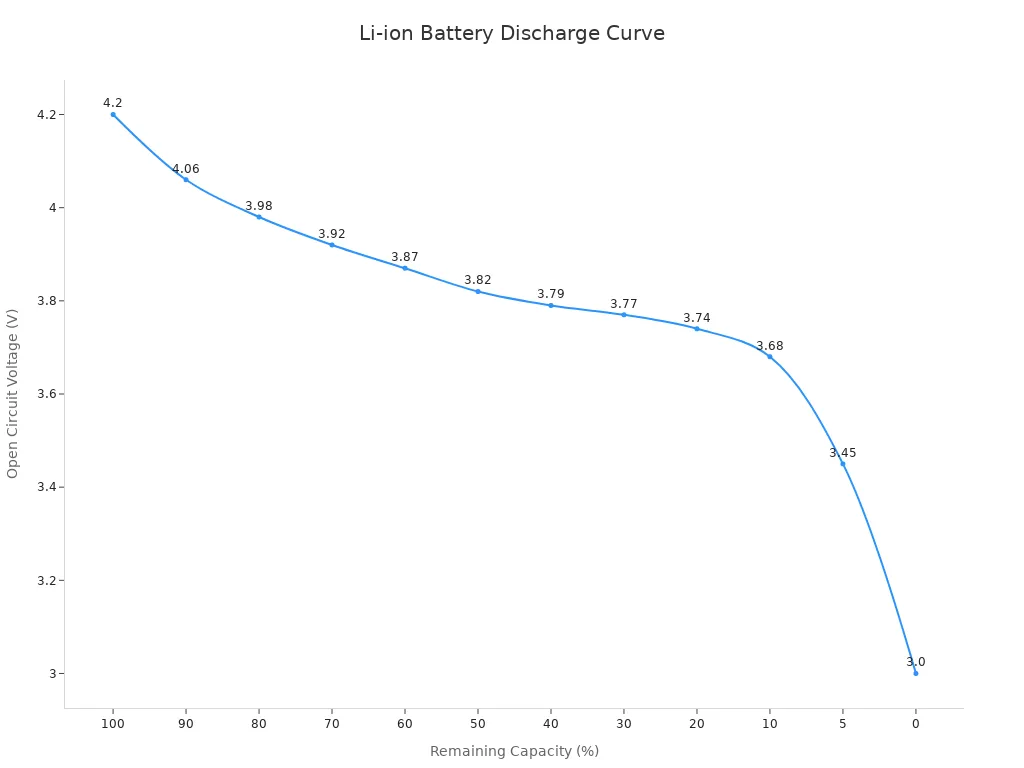
Key features to watch in a discharge curve include the length of the plateau de tension and the speed of the final voltage drop. The c-rate of discharge and temperature both affect these features. A higher discharge rate or colder temperature shortens the plateau and causes the voltage to fall faster. The c-rating tells how quickly a li-ion battery can safely discharge. Exceeding the recommended c-rate of discharge can reduce usable capacity and increase heat.
Health Indicators
The shape of the discharge curve helps diagnose the health of a lithium-ion cell. A healthy li-ion battery shows a long, flat plateau and a gradual voltage drop at the end of discharge. As the battery ages, the plateau shortens and the voltage drops more quickly. Increased internal resistance and reduced discharge capacity signal battery degradation.
| Fonctionnalité | Batterie saine | Batterie dégradée |
|---|---|---|
| Plateau de tension | Long et plat | Court et incliné |
| Chute de tension près de l'extrémité | Graduelle | Rapide |
| Résistance interne | Faible | Haut |
| Capacité de décharge | Haut | Réduit |
| Profil de température | Stable | Plus variable |
Monitoring charge-discharge curves over time allows users to spot early signs of aging. High discharge rates, extreme temperatures, and deep discharges all speed up battery wear. Keeping the li-ion battery within its safe voltage range and recommended c-rating helps maintain performance and extend lifespan.
Real-World Performance
Usable Capacity
In real-world usage, the actual capacity of a 3.7V lithium-ion battery is often less than the rated value. Power banks, for example, use these batteries and advertise their capacity based on the 3.7V rating. However, most devices require a 5V output for charging. The conversion from 3.7V to 5V reduces the available energy. For instance, a 10000mAh battery at 3.7V delivers about 7400mAh at 5V. Additional losses occur due to inefficiencies in the voltage boosting circuit, battery age, and environmental factors like temperature. High-quality power banks may reach up to 93% efficiency, but most users experience about two-thirds of the advertised capacity during normal usage. This difference highlights the importance of understanding how energy conversion and battery quality affect battery performance.
Common Misconceptions
Many consumers misunderstand how lithium-ion batteries work and how to maintain battery performance.
- Some believe that fully discharging the battery before every charge improves lifespan. In reality, frequent partial charging helps extend battery life.
- Others think all rechargeable batteries perform the same, but lithium-ion batteries offer better performance than older types.
- Another myth claims that lithium-ion batteries suffer from a memory effect. Modern batteries do not lose capacity if recharged before full discharge.
- Some users worry about overheating and safety. Advances in battery technology have made lithium-ion batteries much safer and more reliable.
Understanding these facts helps users avoid habits that reduce battery performance and energy efficiency.
Device Matching
Matching the correct battery to a device ensures safe operation and optimal performance.
- Users should check the device manual for the recommended battery type, voltage, and capacity.
- Assessing the device’s power consumption helps determine the necessary battery capacity for the desired runtime.
- The battery voltage must match the device’s requirements to prevent malfunction or damage.
- Physical size and weight also matter for proper fit and safety.
Selecting the right battery improves battery performance, extends device runtime, and prevents safety hazards. Proper device matching also considers battery chemistry, temperature range, and built-in safety features. Careful selection supports reliable energy delivery and consistent discharge during daily usage.
Key Factors
C-Rate Impact
The C-rate describes how quickly a battery charges or discharges relative to its rated capacity. When a 3.7V lithium-ion battery operates at high C-rates, it experiences more stress. Charging above 1C can damage the battery’s lifespan, while keeping the rate below 0.2C helps preserve both performance and capacity retention. High C-rates increase heat and cause faster capacity loss. This stress shortens the cycle life and reduces the available energy during each discharge. Devices that demand rapid charging or high power output should use batteries designed for those conditions. Proper C-rate management ensures stable performance and longer battery life.
Conseil : Always follow manufacturer guidelines for charging and discharging rates to maximize capacity retention and maintain reliable performance.
Effets de la température
Temperature plays a critical role in lithium-ion battery performance and safety. High temperatures speed up chemical reactions inside the battery, which can lead to overheating, pressure build-up, and even combustion. Low temperatures slow down reactions but can cause lithium plating and internal damage, reducing both performance and capacity. The ideal operating temperature for a 3.7V lithium-ion battery is between 15°C and 35°C. Charging should only occur between 0°C and 45°C. Extreme temperatures, whether hot or cold, lower capacity retention and increase the risk of failure. The table below summarizes temperature impacts:
| Temperature Range | Impact sur les performances | Recommendations |
|---|---|---|
| -20°C to 0°C (-4°F to 32°F) | Electrolyte freezing, significant capacity loss | Avoid usage; consider insulation |
| 15°C to 35°C (59°F to 95°F) | Optimal performance, maximum efficiency | Best for usage and charging |
| 35°C to 60°C (95°F to 140°F) | Overheating, reduced lifespan, risk of thermal runaway | Use cooling systems |
| Above 60°C (140°F) | Severe degradation, high safety risk | Avoid at all costs |
Âge de la batterie
Battery age affects both capacity and performance. Over time, repeated charge and discharge cycles cause the battery to lose capacity and increase internal resistance. Scientific studies show that after 300-500 full cycles, most 3.7V lithium-ion batteries begin to degrade. High temperatures and deep discharges speed up this process. Partial discharges between 20% and 80% help extend battery life and maintain better performance. Signs of aging include reduced runtime, slow charging, and overheating. Proper storage at about 50% charge in a cool, dry place helps preserve capacity retention and reliability. With good care, a lithium-ion battery can last up to five years.
Best Practices
Charging Tips
Proper charging practices help maximize battery performance and lifespan. The nominal voltage for a 3.7V lithium-ion battery is 3.6 to 3.7 volts. Full charge voltage reaches 4.2 volts, while the discharge cut-off sits near 3.0 volts. Keeping the voltage within this range prevents overcharging and deep discharge, both of which can cause capacity loss, overheating, and safety hazards. Overcharging above 4.2 volts risks thermal runaway and battery degradation. Discharging below 3.0 volts increases internal resistance and reduces cycle life.
A battery management system monitors and regulates voltage, current, and temperature. This system ensures safe operation and protects the battery from damage. The recommended charging current ranges from 0.5C to 1C of battery capacity. For example, a 1 Ah battery should use a charging current between 0.5 and 1 ampere. The two-stage charging method—constant current until 4.2 volts, then constant voltage with tapering current—delivers the best results.
| Paramètres | Recommendation |
|---|---|
| Full Charge Voltage | 4.2 V per cell |
| Discharge Cut-off Voltage | ~3.0 V per cell |
| Charging Current | 0.5C to 1C of battery capacity |
| Charging Method | CC until 4.2 V, then CV with tapering |
| Optimal Charging Temperature | 15°C to 35°C |
Conseil : Partial charge cycles, such as keeping the battery between 20% and 80% state of charge, extend battery lifespan and improve performance.
Discharge Patterns
Discharge patterns have a direct impact on battery cycle life and performance. Deeper depth of discharge (DoD) shortens cycle life. Batteries discharged to only 20% of their capacity can last up to 2,500 cycles, while those discharged to 100% may last only 300 cycles. Lower C-rates, or slower discharge, reduce battery strain and extend cycle life. High charge and discharge rates, such as rapid charging or high-power discharges, strain the battery and reduce its lifespan.
- Deeper discharges shorten cycle life.
- Shallow discharges (to 50% or less) extend cycle life.
- High charge/discharge rates increase battery wear.
- Moderate temperatures support better performance.
| Depth of Discharge (DoD) | Cycle Life (Number of Cycles) | Notes |
|---|---|---|
| 20% | 2500 | Significantly extends cycle life |
| 40% | 1250 | Moderate cycle life extension |
| 60% | 750 | Reduced cycle life |
| 80% | 500 | Industry standard testing DoD |
| 100% | 300 | Deep discharge shortens cycle life |
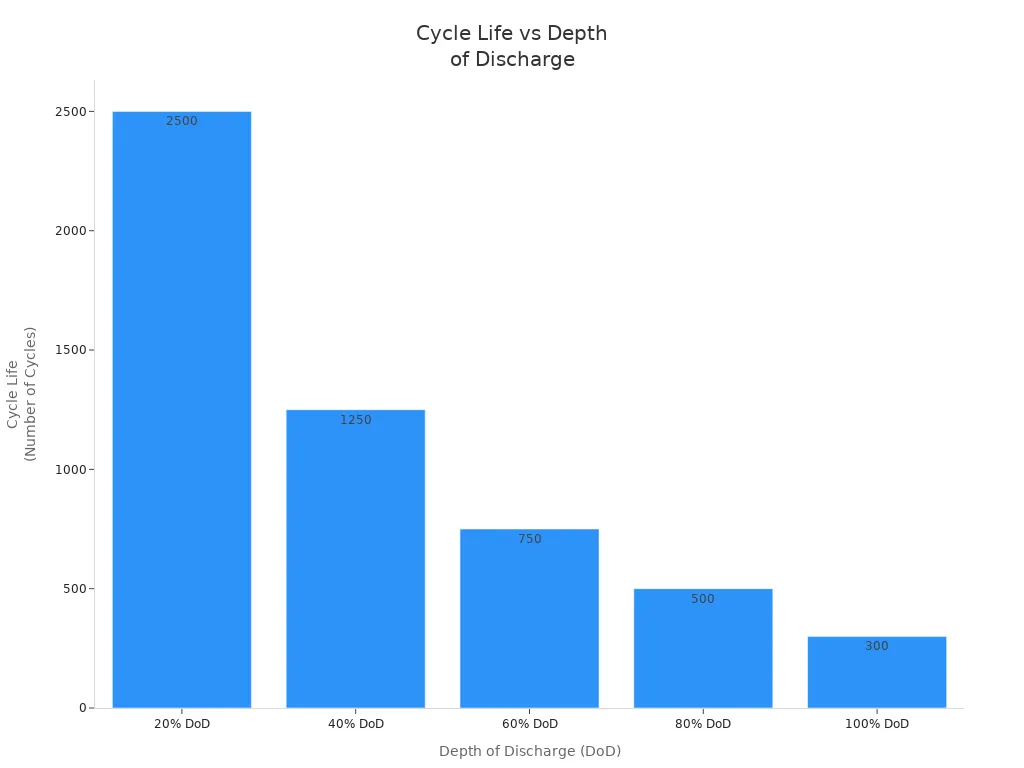
Remarque : Industry warranties, such as Tesla’s 8-year/100,000-mile coverage, highlight the importance of managing discharge patterns for long-term battery performance.
Storage Guidelines
Storing batteries correctly preserves their health and performance. The best storage voltage for a 3.7V lithium-ion battery is between 3.6 and 3.8 volts per cell, which equals about 60–70% charge. This range minimizes chemical reactivity and slows degradation. Avoid storing batteries fully charged or deeply discharged. Full charge increases chemical activity, while low voltage below 2.5 volts can cause irreversible damage.
- Remove batteries from devices before storage to prevent voltage drain.
- Store batteries in dry, well-ventilated areas at room temperature or slightly below.
- Do not refrigerate batteries, as condensation and brittleness may occur.
- Use fireproof safety bags or containers for physical protection.
- Place batteries on non-flammable surfaces, such as concrete or metal.
- Keep batteries separated to avoid direct contact.
- Designate a storage area away from heat sources and high-traffic zones.
- Install smoke detectors and keep a Class D fire extinguisher nearby.
Callout: For other lithium-ion chemistries, such as LFP or LTO, use the manufacturer’s recommended storage voltages.
Lithium-Ion Battery Care
Manufacturers recommend several maintenance practices to extend battery service life and maintain performance. Avoid overcharging and undercharging to prevent overheating and capacity degradation. Use chargers designed for lithium-ion batteries and follow all instructions. Store batteries in cool, dry places away from heat and sunlight, ideally at 40–60% charge if unused for long periods. Use the battery regularly to prevent self-discharge and capacity loss.
- Keep battery contacts clean by gently wiping with a dry cloth.
- Avoid physical damage, such as punctures, crushing, or dropping.
- Recycle old or damaged batteries at designated centers.
- Avoid exposing batteries to extreme temperatures.
- Always use chargers recommended by the manufacturer.
- Utilize built-in battery management systems to monitor battery health.
- Replace batteries that show signs of swelling, overheating, or poor performance.
Reducing the charging voltage below full capacity can extend cycle and service life, though it may lower maximum capacity. Selecting an appropriate charge termination current, such as C/10, prevents overcharging and internal damage. Avoid maintaining full charge voltage after the battery is fully charged to prevent capacity loss and internal short circuits. Monitor battery temperature during charging, ideally between 0°C and 40°C, to prevent overheating and damage.
Safety Reminder: Common safety incidents include internal shorts, separator defects, and exposure to stress conditions. Prevent these by using certified batteries, avoiding improper use, and storing batteries safely. In case of overheating or fire, move the device to a non-combustible surface and use an appropriate fire extinguisher.
Quick Reference
Do’s and Don’ts
Safe use of a 3.7V lithium-ion battery depends on following clear guidelines. Users should always handle batteries with care and pay attention to warning signs. The table below highlights important do’s and don’ts for battery safety and reliable performance.
| Do’s (Recommended) | Don’ts (To Avoid) |
|---|---|
| Avoid charging beyond full capacity or discharging completely | Expose batteries to very high or very low temperatures |
| Maintain battery temperature within safe limits | Allow battery terminals to contact metal causing short circuits |
| Handle batteries gently to prevent shocks or vibrations | Drop or subject batteries to physical impacts |
| Store batteries in dry, ventilated environments | Store batteries in humid or extreme temperature conditions |
| Immediately stop using batteries showing signs of overheating, leaking, or smoke | Continue using batteries with abnormal behavior |
Conseil : Always remove a battery from service if it shows swelling, leaks, or smoke. Quick action prevents further damage and keeps users safe.
Best Practices Table
A quick glance at best practices helps users get the most from their battery. Following these steps improves battery performance and extends service life.
| Best Practice | Benefit |
|---|---|
| Charge between 20% and 80% | Extends battery lifespan |
| Use the correct charger | Prevents overcharging and damage |
| Keep battery at room temperature | Maintains stable performance |
| Store at 60–70% charge in a cool, dry place | Reduces aging and capacity loss |
| Avoid deep discharges | Preserves cycle life and performance |
Users who follow these best practices see better battery reliability and longer device runtime. Consistent care ensures the battery delivers safe and efficient power every day.
Understanding 3.7V lithium-ion battery capacity ratings, discharge curves, and best practices helps users achieve safe and reliable performance.
- Capacity ratings in mAh or Ah show how much energy a battery stores.
- Discharge curves reveal voltage stability and signal when to recharge.
- Following guidelines—such as avoiding deep discharges, using the correct charger, and storing batteries at the right temperature—improves safety and extends battery life.
Regularly checking the quick-reference checklist ensures batteries stay healthy and devices run longer.
FAQ
How can users tell if a 3.7V lithium-ion battery needs replacement?
A battery that charges slowly, loses charge quickly, or feels hot during use often needs replacement. Swelling, leaks, or visible damage also signal the end of battery life. Users should recycle old batteries at approved centers.
What is the safest way to dispose of a damaged lithium-ion battery?
Safety Tip:
Users should never throw damaged batteries in the trash. They must take them to a certified recycling center or hazardous waste facility. This prevents fires and protects the environment.
Can users charge a 3.7V lithium-ion battery with any charger?
No. Users must use a charger designed for lithium-ion batteries with the correct voltage and current ratings. Using the wrong charger can cause overheating, reduced lifespan, or safety hazards.
Why does a battery lose capacity over time?
Chemical reactions inside the battery change with each charge and discharge cycle. Heat, deep discharges, and age speed up this process. Over time, the battery stores less energy and provides shorter runtimes.

